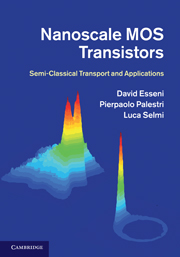Book contents
- Frontmatter
- Contents
- Preface
- Acknowledgements
- Terminology
- 1 Introduction
- 2 Bulk semiconductors and the semi-classical model
- 3 Quantum confined inversion layers
- 4 Carrier scattering in silicon MOS transistors
- 5 The Boltzmann transport equation
- 6 The Monte Carlo method for the Boltzmann transport equation
- 7 Simulation of bulk and SOI silicon MOSFETs
- 8 MOS transistors with arbitrary crystal orientation
- 9 MOS transistors with strained silicon channel
- 10 MOS transistors with alternative materials
- Appendices
- Index
8 - MOS transistors with arbitrary crystal orientation
Published online by Cambridge University Press: 05 August 2011
- Frontmatter
- Contents
- Preface
- Acknowledgements
- Terminology
- 1 Introduction
- 2 Bulk semiconductors and the semi-classical model
- 3 Quantum confined inversion layers
- 4 Carrier scattering in silicon MOS transistors
- 5 The Boltzmann transport equation
- 6 The Monte Carlo method for the Boltzmann transport equation
- 7 Simulation of bulk and SOI silicon MOSFETs
- 8 MOS transistors with arbitrary crystal orientation
- 9 MOS transistors with strained silicon channel
- 10 MOS transistors with alternative materials
- Appendices
- Index
Summary
In the previous chapters we considered devices featuring a silicon channel and a (001) transport plane. These assumptions simplify calculation of the electron subband structure with the EMA approach, since one of the principal axes of the constant energy ellipsoids of the Δ valleys is aligned to the quantization direction. Furthermore, we have considered the [100] transport direction, which is again aligned to one of the principal axes of the constant energy ellipses in the transport plane.
In this chapter we show that semi-classical transport modeling in the frame of multi subband theory can be supplemented to describe arbitrary orientations by extending quite naturally most of the theoretical concepts explained in the previous chapters. In particular we generalize to arbitrary materials and crystal orientations the EMA (for electron inversion layers) and the k·p model (for hole inversion layers) discussed in Chapter 3.
We demonstrate the application of the theory by comparing results for silicon MOSFETs with non-conventional crystal orientations, namely (110) and (111), to the ones for the conventional (001) orientation.
The general theory is also used in Chapter 10 to analyze some alternative channel materials such as germanium and gallium arsenide.
Electron inversion layers
We appreciated in Section 3.2.1 the usefulness of the effective mass approximation (EMA) for analysis of the electron inversion layer, particularly when the dispersion relationship is assumed to be parabolic and the constant energy surfaces of the bulk crystal are ellipsoids.
- Type
- Chapter
- Information
- Nanoscale MOS TransistorsSemi-Classical Transport and Applications, pp. 348 - 365Publisher: Cambridge University PressPrint publication year: 2011
- 1
- Cited by

